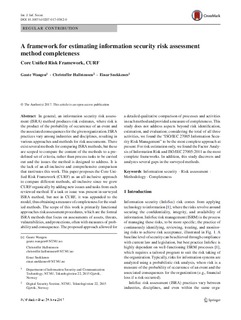| dc.contributor.author | Wangen, Gaute | |
| dc.contributor.author | Hallstensen, Christoffer V | |
| dc.contributor.author | Snekkenes, Einar Arthur | |
| dc.date.accessioned | 2017-08-07T10:00:07Z | |
| dc.date.available | 2017-08-07T10:00:07Z | |
| dc.date.created | 2017-06-29T10:18:16Z | |
| dc.date.issued | 2017 | |
| dc.identifier.issn | 1615-5262 | |
| dc.identifier.uri | http://hdl.handle.net/11250/2450010 | |
| dc.description.abstract | In general, an information security risk assessment (ISRA) method produces risk estimates, where risk is the product of the probability of occurrence of an event and the associated consequences for the given organization. ISRA practices vary among industries and disciplines, resulting in various approaches and methods for risk assessments. There exist several methods for comparing ISRA methods, but these are scoped to compare the content of the methods to a predefined set of criteria, rather than process tasks to be carried out and the issues the method is designed to address. It is the lack of an all-inclusive and comprehensive comparison that motivates this work. This paper proposes the Core Unified Risk Framework (CURF) as an all-inclusive approach to compare different methods, all-inclusive since we grew CURF organically by adding new issues and tasks from each reviewed method. If a task or issue was present in surveyed ISRA method, but not in CURF, it was appended to the model, thus obtaining a measure of completeness for the studied methods. The scope of this work is primarily functional approaches risk assessment procedures, which are the formal ISRA methods that focus on assessments of assets, threats, vulnerabilities, and protections, often with measures of probability and consequence. The proposed approach allowed for a detailed qualitative comparison of processes and activities in each method and provided a measure of completeness. This study does not address aspects beyond risk identification, estimation, and evaluation; considering the total of all three activities, we found the “ISO/IEC 27005 Information Security Risk Management” to be the most complete approach at present. For risk estimation only, we found the Factor Analysis of Information Risk and ISO/IEC 27005:2011 as the most complete frameworks. In addition, this study discovers and analyzes several gaps in the surveyed methods. | nb_NO |
| dc.language.iso | eng | nb_NO |
| dc.publisher | Springer Verlag | nb_NO |
| dc.rights | Navngivelse 4.0 Internasjonal | * |
| dc.rights.uri | http://creativecommons.org/licenses/by/4.0/deed.no | * |
| dc.title | A framework for estimating information security risk assessment method completeness: Core Unified Risk Framework | nb_NO |
| dc.type | Journal article | nb_NO |
| dc.type | Peer reviewed | nb_NO |
| dc.description.version | publishedVersion | nb_NO |
| dc.source.journal | International Journal of Information Security | nb_NO |
| dc.identifier.doi | 10.1007/s10207-017-0382-0 | |
| dc.identifier.cristin | 1479746 | |
| dc.description.localcode | © The Author(s) 2017. This article is distributed under the terms of the Creative Commons Attribution 4.0 International License (http://creativecommons.org/licenses/by/4.0/), which permits unrestricted use, distribution, and reproduction in any medium, provided you give appropriate credit to the original author(s) and the source, provide a link to the Creative Commons license, and indicate if changes were made. | nb_NO |
| cristin.unitcode | 194,18,21,80 | |
| cristin.unitcode | 194,18,24,10 | |
| cristin.unitname | Norwegian Information Security Lab | |
| cristin.unitname | IT-seksjonen Gjøvik | |
| cristin.ispublished | true | |
| cristin.fulltext | original | |
| cristin.qualitycode | 2 | |

